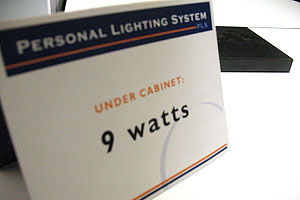 I've been a cheerleader for compact fluorescent lamps (CFL) in this blog and will abandon the technology in a millisecond. When it comes to technology, my loyalties are short lived. I'm writing this from Asilomar State Park in Pacific Grove, California, during the American Council for an Energy Efficient Economy (ACEEE) bi-annual Summer Study on energy use in buildings. Early in the week, the plenary speaker and a 2008 ACEEE Champion of Energy Efficiency, Philips Lighting's Kevin Dowling, Vice President for Innovation in Solid State Lighting, turned my head from CFLs to light emitting diodes (LEDs), my new little darling, hero, and true lighting love.
I've been a cheerleader for compact fluorescent lamps (CFL) in this blog and will abandon the technology in a millisecond. When it comes to technology, my loyalties are short lived. I'm writing this from Asilomar State Park in Pacific Grove, California, during the American Council for an Energy Efficient Economy (ACEEE) bi-annual Summer Study on energy use in buildings. Early in the week, the plenary speaker and a 2008 ACEEE Champion of Energy Efficiency, Philips Lighting's Kevin Dowling, Vice President for Innovation in Solid State Lighting, turned my head from CFLs to light emitting diodes (LEDs), my new little darling, hero, and true lighting love.
Philips Lighting was the first manufacturer to commercialize CFL bulbs in the 1970s, and has long been an innovator, as well as being the largest manufacturer of lighting products in the world. "We aren't even near the limits to this technology," said Dowling. Technically, solid-state lighting, or LED lighting, is ready to be the next big thing after CFLs. The challenge that remains is making LED lighting affordable and ubiquitous. That is a challenge when you consider that today's incandescents work in 1880s-style fixtures. Dowling proved it in a backroom of the Smithsonian in Washington D.C. And in the progressive Pacific Northwest, after 15 years on the market, CFLs have achieved only 8% market penetration.
But LEDs are an easy sell. Compared to incandescent lights, which produce 10–12 lumens per watt (lpw), and fluorescents, which produce 90-100 lpw, the best LEDs produce approximately 100 lpw, have the potential to reach the 150–200 lpw level, can last 35 years and don't release any mercury into the environment. History has shown that the cost of LED technology has decreased, while performance has increased-- both exponentially. Dowling expects LED lighting performance to continue increasing 35% per year while the price decreases about 20% per year, and that in 24-36 months LED lighting will reach the level of linear fluorescent lights in light output per watt of energy use.
LEDs have evolved from mostly lighting that attracts attention to lighting that illuminates. LEDs can produce a range of color temperatures, from cool to warm. It has been installed in the Old North Church in Boston to rave reviews from the curators of the historic church. Legislation is supporting the evolution of the lighting technology. Legislation and guidelines will raise lighting efficacy to at least 45 lpw by 2020, according to Dowling, making LEDs an easy choice.
Goodbye CFLs, it was good while it lasted.
